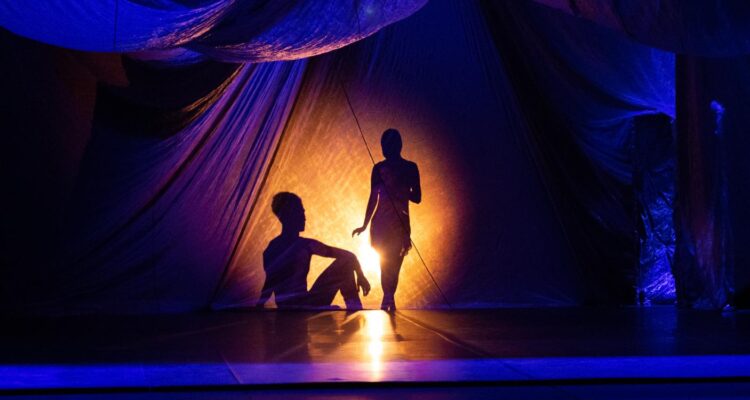‘Lazgi’ takes its name from a style of dance in Western Central Asia, which literally translates as ‘trembling’. It is associated with the ritual pratices of Zoastrianism and manifests itself first in a series of fluttering hand movements which then develop into patterns of shaking and gyration that gradually take over the whole body. These symbolise and demonstrate the way in which love and the soul enter and control the body under the power of music.
This itself would be an interesting framework for an evening of dance, but the particular skill and insight in this production lies in the way that choreographer Raimondo Rebeck marries this tradition with the classical training of the National Ballet of Uzbekistan to create a smoothly integrated and rewarding fusion of the two very different styles of dance. While the scenario presented – four highly contrasted scenes – does not make complete sense, in the end this does not matter much because there is stylistic continuity and interest throughout together with impressive staging and quite spectacular lighting effects.
As we begin, heavily ominous music heralds the arrival of an exhausted woman onstage. She is revived by a shaman and chorus and introduced to the leader of the community and a romantic connection is established with exquisite movement and shadow play. By the end of the first scene a trio of characters, unusually two female and one male, has been established that is then pursued as a dramatic device through the rest of the action, punctuated by interventions from the group dancers, whether using ‘lazgi’ or classical techniques.
The next two scenes seek to integrate tradition and modernity. We find ourselves in a museum where interaction develops between modern visitors and dancers in glass cases representing entombed costumes and ancient dance techniques. In another disruptive scene, ostinato phrases in the style of minimalist composers such as Glass and Reich are used to underpin deliberately repetitive movements representing the deadening impact of office routines, before these are contrasted with the traditional rhythms of ‘lazgi.’ Perhaps the final scene is the most magisterial, in which rows of lit candles appear above the stage and the orchestra pit between which dancers weave as couples and as collective groups of men and women in intricate and compelling choreography.
The creative contributions from other media are very important to the show’s success. The music, put together by Davidson Jaconello, uses a skilful blend of traditional and electronic instruments and sounds which liberate and enable the dancers, finding both lyricism and aggressive vigour, as needed. Costumes by Frol Burimsky skilfully reflect the stylistic contrasts of the music, with detailed, voluminous, ethnic constumes vying with subdued, body-hugging discreet minimalism. Perhaps the lighting is the most impressive contributory factor here. A huge silk curtain furls and unfurls itself at intervals to simulate a tent and a sandstorm or a billowing cloak. The lighting design recolours and reshapes it with video projections as the mood of the music and dancers shifts. This is a wonderfully effective and economical device and makes the transitions between scenes especially memorable rather than simply practical and necessary.
It is a pity that none of the individual dancers are identified, as it would be good to be able to praise their particular contributions, but collectively this was an inspiring evening in which great technical skill was matched with imaginative inspiration to produce a sequence of scenes of stunning beauty and emotional power. The show deserved more than one evening at the Coliseum, and for those who saw it our memories and impressions will linger and resonate for a long time.
National Ballet of Uzbekistan
Idea Author: Saida Mirziyoyeva
Project Manager: Gayane Umerova
Libretto and Choreography: Raimondo Rebeck
Scenography: Yoko Seyama
Costume Designer: Frol Burimsky
Music Arrangement and Composition: Davidson Jaconello
Lighting Designer: Tim Vaclavic
14 September 2024
90 mins with interval

